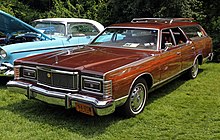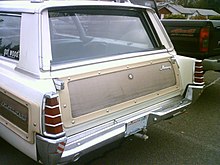Grand Marquis Colony Park
Motor vehicle
| Mercury Colony Park | |
|---|---|
 1984 Colony Park | |
| Overview | |
| Manufacturer | Mercury (Ford) |
| Model years | 1957–1991 |
| Assembly | St. Louis, Missouri Pico Rivera, California Atlanta, Georgia Mahwah, New Jersey |
| Body and chassis | |
| Class | Full-size |
| Body style | 4-door station wagon |
| Layout | FR layout |
| Chronology | |
| Predecessor | Mercury Monterey station wagon |
The Mercury Colony Park is a full-size station wagon that was marketed by the Mercury division of Ford Motor Company between 1957 and 1991. Distinguished by its simulated wood-grain paneling, the Colony Park was marketed as either the premium-trim or the sole full-size station wagon offering of the division. Following the demise of Edsel, full-size Mercury and Ford vehicles adopted similar bodyshells, with the Colony Park becoming the counterpart of the Ford Country Squire until their discontinuation.
As the minivan and four-door SUV segment expanded in the late 1980s, sales of full-size station wagons declined, including the Colony Park. As the Ford Crown Victoria and Mercury Grand Marquis sedans underwent a major redesign for the 1992 model year, the station wagon body style was dropped from the model lineup, leaving the Colony Park with no direct replacement (through the closure of the Mercury brand in 2010).
First generation (1957–1958) [edit]
Motor vehicle
| First generation | |
|---|---|
 1957 Mercury Colony Park | |
| Overview | |
| Model years | 1957–1958 |
| Body and chassis | |
| Related | Mercury Turnpike Cruiser Mercury Park Lane Mercury Montclair Mercury Monterey Mercury Voyager Mercury Commuter Edsel Citation Edsel Corsair |
| Powertrain | |
| Engine | 368 cu in (6.0 L) Lincoln Y-Block V8 383 cu in (6.3 L) Marauder V8 430 cu in (7.0 L) Super Marauder V8 |
| Transmission | 3-speed manual 3-speed Merc-O-Matic automatic |
| Dimensions | |
| Wheelbase | 122.0 in (3,099 mm)[1] |
| Length | 1957: 211.1 in (5,362 mm) 1958: 214.2 in (5,441 mm) |
| Width | 79.1 in (2,009 mm)[1] |
| Height | 58.3 in (1,481 mm) |
| Curb weight | 4,400–4,800 lb (2,000–2,200 kg) |
For 1957, the Mercury model line underwent major revisions. Instead of sharing bodies with trim distinguishing each division, Edsel and Mercury would share the chassis and powertrain (an all-new line of V8 engines), with each model line having different wheelbases and completely distinct exterior panels.
Another change involved the branding of station wagons, involving both Ford and Mercury. Split away from the Monterey model line, Mercury introduced three new station wagons as a separate model line for 1957. Two-door and four-door station wagons were sold as a base-trim Mercury Commuter and mid-price Mercury Voyager; the top-trim wood-grained Mercury Colony Park was sold with only four-doors. To distinguish itself from Ford (and Edsel), all Mercury station wagons given hardtop rooflines.
Marketed as the flagship of the Mercury station wagon model line (alongside the Ford-based Edsel Bermuda sold only for 1958), the Mercury Colony Park was trimmed similar to the Mercury Montclair, above the Monterey. The interior featured an electric clock as a standard feature; a padded dash was optional.[1] [2]
Sharing its powertrain with the Montclair and the Mercury Turnpike Cruiser, the 1957 Colony Park was fitted with a 368 cubic-inch Lincoln Y-Block V8. For 1958, the Y-block was replaced by two "MEL" V8s. The standard engine was a 383 cubic-inch V8 with a 430 cubic-inch V8 available as an option; a "Super Marauder" triple-carburetor option for the 430 was the first American mass-production engine rated at 400 hp.
Second generation (1959–1960) [edit]
Motor vehicle
| Second generation | |
|---|---|
 | |
| Overview | |
| Model years | 1959–1960 |
| Body and chassis | |
| Related | Mercury Park Lane Mercury Montclair Mercury Monterey Mercury Commuter |
| Powertrain | |
| Engine | 383 cu in (6.3 L) Marauder V8 430 cu in (7.0 L) Super Marauder V8 |
| Transmission | 3-speed Merc-O-Matic automatic |
| Dimensions | |
| Wheelbase | 126.0 in (3,200 mm) |
| Length | 1959: 218.2 in (5,542 mm) 1960: 219.2 in (5,568 mm) |
| Width | 1959: 80.7 in (2,050 mm) 1960: 81.5 in (2,070 mm) |
| Height | 57.8 in (1,468 mm) |
| Curb weight | 4,800–4,900 lb (2,200–2,200 kg) |
For the 1959 model year, the Mercury Colony Park underwent a complete redesign. Following the introduction of the 1958 Mercury Park Lane, the Colony Park (and the rest of the Mercury line) extended its wheelbase to 126.0 in (3,200 mm). Originally intended to share a chassis with the premium Edsel Corsair and Edsel Citation (Edsel wagons were Ford-based, including the woodgrain Edsel Bermuda), the Mercury division was left with its own chassis for 1959.
As with the previous generation, the station wagon line remained distinct from Mercury sedans; the Mercury Voyager and the two-door Mercury Commuter were dropped. As before, all four-door Mercury station wagons were produced with hardtop rooflines.
For 1959, the Colony Park shared its 322hp Marauder V8 with the Montclair and Monterey. For 1960, the 430 V8 made its return. In place of the 400hp Super Marauder triple-carburetor version, a single 4-barrel carburetor was fitted, reducing output down to 310 hp; this engine was shared with Lincoln, Continental, and the Ford Thunderbird. As with the previous generation, both engines were paired with the Merc-O-Matic 3-speed automatic transmission.
Third generation (1961–1964) [edit]
Motor vehicle
| Third generation | |
|---|---|
 1963 Colony Park | |
| Overview | |
| Model years | 1961–1964 |
| Body and chassis | |
| Related | Mercury Park Lane Mercury Montclair Mercury Monterey Mercury Meteor Mercury Commuter Ford Galaxie Ford Fairlane Ford 300 Ford Custom Ford Country Squire |
| Dimensions | |
| Wheelbase | 120.0 in (3,048 mm) |
Following the closure of the Edsel division during the 1960 model year, Ford product planners scrambled to build to a better business case for both Lincoln and Mercury divisions. To decrease its production costs, Mercury ended its use of a division-specific chassis and streamlined its product range, with full-size sedans reduced largely to the Monterey. Mercury station wagon nameplates remained the same, with the Commuter differentiated from the Colony Park (by its lack of wood-grain trim). In following with the compact Mercury Comet, all full-size 1961 Mercury lines began production using Ford bodywork and chassis. Now sharing its roofline with the Ford Country Squire, the Colony Park moved from sharing its interior trim from the Montclair to the Monterey.
Though the 1961 redesign of the Mercury product line was not intended as downsizing, the transition between second and third generations marked a significant decrease in exterior dimensions. From 1960 to 1961, the Mercury Colony Park shed approximately five inches in length, six inches in wheelbase, and approximately 500 pounds of curb weight.
In place of the 430 MEL V8, Mercury fitted the Colony Park with three separate V8 engines. A 292 Y-Block V8 was the standard engine for 1961 and 1962, with 352 and 390 FE V8s as options. In 1963, the 390 became the standard engine. For the first time, 3 and 4-speed manual transmissions were offered in the Colony Park, with 3-speed Merc-O-Matic as an option.
-

1962 Mercury Colony Park
Fourth generation (1965–1968) [edit]
Motor vehicle
| Fourth generation | |
|---|---|
 1965 Colony Park | |
| Overview | |
| Model years | 1965–1968 |
| Body and chassis | |
| Related | Mercury Commuter Ford Country Squire Mercury Marquis/Mercury Monterey Ford LTD/Ford Galaxie |
| Powertrain | |
| Engine | 390 cu in (6.4 L) FE V8 410 cu in (6.7 L) Marauder V8 |
| Dimensions | |
| Wheelbase | 119.0 in (3,023 mm) |
For 1965, Ford redesigned its entire full-size sedan and station wagon product line, including the Mercury Colony Park. While retaining a body-on-frame chassis, the leaf-sprung rear suspension was replaced by a coil-spring live rear axle configuration; through several design changes, the basic layout would be retained through the final Crown Victoria produced in 2011. While the Colony Park retained its roofline alongside the Ford Country Squire, it adopted the slab-sided design language taken on by Mercury sedans, heavily influenced by the exterior of the Lincoln Continental.
Through this generation, Mercury would make several design changes. For 1966, the rear tailgate was updated, marking the debut of the two-way "Magic Doorgate" shared with all other Ford and Mercury station wagons; the design allowed the tailgate to fold down as a tailgate as well as swing oututo the drivers' side as a door. For 1967, passenger capacity was expanded as sideways-facing third-row seats were added as an option. To increase ventilation for the rear of the vehicle, the Colony Park introduced fresh-air ventilation through channels integrated into the D-pillar, allowing ventilation if the rear window was retracted.
The Colony Park underwent two exterior revisions, in 1967 and 1968, following Lincoln Continental styling updates; redesigns were made to the simulated wood paneling. For 1967 and 1968, the Mercury Park Lane coupe and convertible featured the same simulated wood paneling as the Colony Park as an option package. Called "yacht deck paneling" by Mercury, the option was rarely ordered and was discontinued as the Park Lane was replaced by the Mercury Marquis.
For 1965, the 390 V8 was the sole engine. In 1966, Mercury added two additional FE V8s, a 330 hp 410 "Marauder" V8[3] and a 345 hp 428 "Super Marauder" V8. For 1968, the 410 was dropped, replaced by a 315 hp version of the 390 V8.
| | 1966 2-way tailgate with side-swing door handle |
Fifth generation (1969–1978) [edit]
Motor vehicle
| Fifth generation | |
|---|---|
 1974 Colony Park | |
| Overview | |
| Production | September 1968–October 1978[ citation needed ] |
| Model years | 1969–1978 |
| Assembly | Hazelwood, Missouri (St. Louis Assembly Plant) Pico Rivera, California (Los Angeles Assembly) Hapeville, Georgia (Atlanta Assembly) |
| Body and chassis | |
| Layout | FR layout |
| Related | Ford LTD Ford Country Squire Ford Galaxie Mercury Grand Marquis Mercury Marquis |
| Powertrain | |
| Engine |
|
| Dimensions | |
| Wheelbase | 121.0 in (3,073 mm) |
| Length | 220.5 in (5,601 mm) |
| Width | 81.1 in (2,060 mm) |
| Curb weight | 4,740 lb (2,150 kg) |


Alongside a redesign for the 1969 model year, Ford integrated its station wagon product lines of both Ford and Mercury brands within the nameplates of their sedan counterparts.[4] For the Colony Park, this change made it part of the Mercury Marquis model line. In contrast to the Marquis sedan, the Colony Park was based on the 121.0 in (3,073 mm) wheelbase of the Ford Country Squire and the Ford LTD.[4]
This generation introduced covered headlights, which were deployed using a vacuum canister system that kept the doors down when a vacuum condition existed in the lines, provided by the engine when it was running. If a loss of vacuum occurred, the doors would retract up so that the headlights were visible if the system should fail.[4] The Magic Doorgate was reworked so that it could swing outward without having to roll the window down.[4]
Coinciding with the addition of 5–mph bumpers, Ford and Mercury station wagons underwent a major redesign for 1973, including a completely new roofline. In place of the framed doors, the station wagons were marketed as "pillarless hardtops"; though the roof was fitted with slim B-pillars, the doors were fitted with frameless door glass.
Although narrower than the 1959–1960 generation, this generation of the Colony Park would be the longest and heaviest station wagon ever sold by Mercury. Due to its nearly 5,000 lb curb weight, the standard engine was a 400 cubic-inch V8 with a 429 cubic-inch V8 as an option; in 1972, the 429 was replaced by a 460 cubic-inch V8 sourced from Lincoln. For the 1978 model year, a 351 Windsor V8 became standard (outside of California and high-altitude areas), with the 400 and 460 as options.[4] However, most surviving examples are equipped with one of the two larger V8 engines, as they were far more popular, with the 351 proving to have little fuel-economy gains.
Approximately 7,850,000 full-size Fords and Mercurys were sold over 1969-1978.[5] [6] This makes it the second-best selling Ford automobile platform after the Ford Model T.[4]
Sixth generation (1979–1991) [edit]
Motor vehicle
| Sixth generation | |
|---|---|
 | |
| Overview | |
| Production | October 1978–December 1990[ citation needed ] |
| Model years | 1979–1991 |
| Assembly | Hazelwood, Missouri (St. Louis Assembly) Talbotville, Ontario, (St. Thomas Assembly) |
| Body and chassis | |
| Platform | Ford Panther platform |
| Related | Ford LTD Ford Country Squire Ford LTD Crown Victoria Mercury Grand Marquis Mercury Marquis |
| Powertrain | |
| Engine | 302 cu in (4.9 L) 5.0 Windsor V8 351 cu in (5.8 L) Windsor V8 |
| Transmission | 3-speed C4 automatic 3-speed FMX automatic 4-speed AOD automatic |
| Dimensions | |
| Wheelbase | 114.3 in (2,903 mm) |
| Length | 219 in (5,563 mm) |
| Width | 79.3 in (2,014 mm)[7] |
| Height | 56.5 in (1,435 mm)[7] |
| Curb weight | 4,032 lb (1,829 kg) [7] |
For 1979, Ford redesigned its full-size sedan and station wagons; the Ford Panther platform brought Ford in line with the downsizing introduced by the 1977 General Motors B-body full-size cars. To remain competitive (in terms of size and fuel economy) with the Buick Estate and Oldsmobile Custom Cruiser (1978 marked the end of the full-size Chrysler Town & Country station wagon), Ford made extensive changes to its full-size station wagons. In terms of size, the 1979 Colony Park shed over 11 inches in length, 6.6 inches in wheelbase, 0.4 inches in width, and had lost slightly over 1,000 lbs in weight (in comparison to its 1978 predecessor).[8] Though technically smaller than the "intermediate" Montego/Cougar station wagon, the Colony Park reduced its cargo-carrying capability only slightly over the 1978 Colony Park. As before, 8-passenger seating remained standard equipment.
In a revision of the Mercury product range, the Colony Park was moved to the Grand Marquis model line, the flagship of the Mercury brand. Effectively, it placed the Colony Park above its Country Squire counterpart in terms of trim; also, the decision also cleared room for a Marquis station wagon without woodgrain trim.
In the interest of fuel economy, the Mercury Colony Park underwent an extensive revision of its powertrain lineup. Although V8 power remained in place, the 400 and 460 V8 engines were removed from all Ford cars, with the Colony Park sharing the 302 Windsor V8 with the Mercury Monarch, the previous base 351 Windsor V8 was offered as an option. For 1981, Ford and Mercury underwent the powertrain revisions of the 1980 Lincoln Continental; the 302 V8 was given fuel injection (now marketed in metric as a "5.0 L"), with both engines paired to the 4-speed AOD overdrive transmission, the first of its type in an American full-size car. For 1982, the fuel-injected "5.0" V8 became the sole engine offering in all Mercury full-size cars. During 1986, the carbureted 5.8 L V8 returned as an option; examples specified with this engine are rare.
This generation of Colony Park would see few substantial changes during its thirteen-year lifespan. For 1983, it became the sole full-size Mercury wagon as the previous year's 'base' Marquis wagon was no longer offered as a full-size model. For 1984, the non-woodgrain Grand Marquis (previously Marquis) station wagon was dropped, leaving the Colony Park as the sole version. For 1987, Mercury brought the Colony Park in line with the Sable and Topaz by introducing GS and LS trim levels.
After nine years with only detail changes to the body and trim, the Colony Park received a major update alongside the Grand Marquis for 1988. From the windshield forward, a more aerodynamic front end better integrated the fenders, grille, headlights, and bumpers. Inside, the front seats were modernized. For 1990, as part of an addition of a driver's side airbag, the entire instrument panel and dashboard received a redesign; all outboard seats received 3-point seatbelts. 1991 was the final shortened model year for the Colony Park with production ending in December 1990.
-

1979–1987 Mercury Colony Park front
-

1984 Mercury Colony Park rear
| Year | 1979 | 1980 | 1981 | 1982 | 1983 | 1984 | 1985 | 1986 | 1987 | 1988 | 1989 | 1990 | 1991 | Total production |
|---|---|---|---|---|---|---|---|---|---|---|---|---|---|---|
| Units | 13,758 | 5,781 | 6,293 | 8,004 | 12,394 | 17,421 | 14,119 | 9,891 | 10,691 | 9,456 | 8,665 | 4,450 | 3,104 | 124,027 |
References [edit]
- ^ a b c Flory, Jr., J. "Kelly" (2008). American Cars, 1946–1959 Every Model Every Year. McFarland & Company, Inc., Publishers. ISBN978-0-7864-3229-5.
- ^ http://www.oldcarbrochures.com/static/NA/Mercury/1957%20Mercury/1957_Mercury_Brochure/1957%20Mercury%20Brochure-31.html
- ^ 1968 Kelley Blue Book
- ^ a b c d e f Odin, L.C. A concise guide to the Ford and Mercury full-size automobile production 1969-1978. Belvedere Publishing, 2016. ASIN: B01HE91Y4K.
- ^ Kowalke, Ron (1997). Standard Catalog of American Cars 1946–1975 . Krause publications. ISBN0-87341-521-3.
- ^ Flammang, James Standard Catalog of American Cars 1976–1999 3rd Edition (Iola, WI: Krause Publications, Inc 1999)
- ^ a b c http://www.edmunds.com/mercury/grand-marquis/1991/features-specs.html?style=2497
- ^ http://www.automobile-catalog.com/auta_cmp2.php
- ^ "Box Panther Production Numbers". Retrieved 21 February 2014.
- Standard Catalog of Ford 1903–1998 by Krause Publications ISBN 0-87341-636-8
External links [edit]
- Grandmarq.net - forum dedicated to the Ford, Lincoln, and Mercury Panther Chassis
Source: https://en.wikipedia.org/wiki/Mercury_Colony_Park



0 Komentar